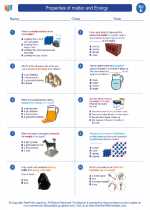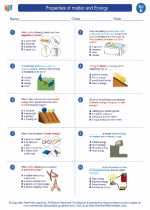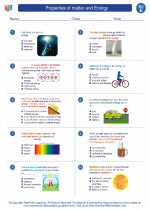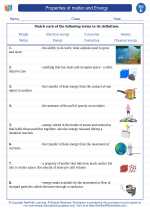Properties of matter and Energy -> state of matter
State of Matter
Everything around us is made up of matter, which exists in different states. The three primary states of matter are solid, liquid, and gas. Understanding the characteristics and behavior of each state is an essential concept in science.
Solid
A solid is a state of matter with a definite shape and volume. Particles in a solid are tightly packed together and vibrate in place. They have a fixed position and do not move around freely. Solids are not easily compressed and tend to maintain their shape unless acted upon by an external force.
Liquid
Liquids have a definite volume, but they take the shape of their container. The particles in a liquid are not as tightly packed as in a solid, allowing them to move around each other. This is why liquids can flow and be poured. Like solids, liquids are not easily compressed.
Gas
Gases have neither a definite shape nor a definite volume. The particles in a gas move freely and are much farther apart compared to solids and liquids. Gases can fill any container they are placed in and are easily compressed. They also have the ability to expand to fill the space available to them.
Changes in State
Matter can change from one state to another through the processes of melting, freezing, evaporation, condensation, and sublimation. These changes are caused by adding or removing energy from the system.
Study Guide
- Define the three primary states of matter.
- Describe the characteristics of solids, liquids, and gases.
- Explain how matter changes from one state to another.
- Provide examples of each state of matter in everyday life.
- Discuss the concept of compressibility and how it applies to the different states of matter.
◂Science Worksheets and Study Guides Fifth Grade. Properties of matter and Energy

 Worksheet/Answer key
Worksheet/Answer key
 Worksheet/Answer key
Worksheet/Answer key
 Worksheet/Answer key
Worksheet/Answer key
 Vocabulary/Answer key
Vocabulary/Answer key
 Vocabulary/Answer key
Vocabulary/Answer key
